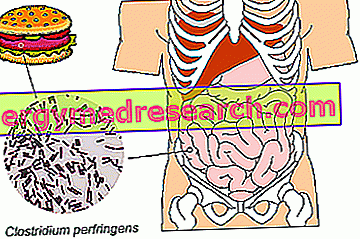What are
What are edamame?
Edamame is the Japanese name for boiled soybean pods.

More precisely, they are whole fruits, therefore still closed, containing the slightly immature green seeds of the herbaceous plant belonging to the Fabaceae Family, Genus Glycine and species max .
Like all legumes, soy is also classified in the IV fundamental group of foods. Provides a significant amount of calories, divided between all three energy macronutrients; the lipid fraction is particularly interesting, with an excellent percentage of omega 3 essential polyunsaturated fatty acids (alpha linolenic acid - ALA); also good protein, rich in essential amino acids, and the remainder of complex carbohydrates. Other important nutrients of edamame are: different mineral salts, lipo and water-soluble vitamins, and several phytoelements such as lecithins and phytosterols.
Did you know that ...
Soy is considered by many to be a diet food. It is a half truth, in the sense that - in the context of Western diets - it can exercise a positive nutritional role but, at the same time, it provides several calories deriving from lipids - not as much as peanuts, but much more than borlotti, broad beans, chickpeas, lentils, lupins, cannellini beans, azuki, gods with an eye, etc.
The recipe for edamame beans involves cooking whole pods by boiling; this can be done by steam, by drowning in cold water or in the microwave. Salting, if desired, takes place with half the salt directly on the pods - without shelling. The edible portion is made up of soy beans closed inside the pod, or the seeds, which are served exclusively natural or lightly seasoned to taste.
Edamame are typical products of Chinese, Japanese, Korean and Hawaiian cuisine. Outside East Asia - for example in Italy - edamame beans can be found mainly in ethnic and dietary shops and restaurants - for example macrobiotics. Edamame are marketed mainly fresh, packed in frozen blocks or cans.
Nutritional Properties
Nutritional properties of edamame
Edamame belong to the IV fundamental group of foods. Like many other soy-based preparations, boiled immature beans also contain excellent percentages of water, "vegetable" proteins, carbohydrates, lipids, fibers and various micronutrients; let's go into more detail.
Did you know that ...
The differentiation between plant and animal proteins has now completely lost its importance. In fact, all the proteins available in nature are composed of the same basic amino acids; what distinguishes them is their proportion and organization. Once digested, they are broken down into individual "bricks", totally disregarding the initial configuration. However, it must be emphasized that certain studies have also strongly questioned this hypothesis; it is hypothesized that, as a substitute for animal ones, vegetable proteins may be protective against certain pathological and tumoral pathologies. It remains to be clarified what the specific mechanism in question might be.
Edamame are characterized by a significant but not excessive caloric intake, which depends above all on the excellent percentage of water contained in the seeds that are still fresh and immature. The fraction of macronutrients is quantitatively more abundant than that of proteins, followed by carbohydrates and finally by fats; they provide an almost identical percentage of calories, with a slight prevalence of lipids. Carbohydrates are mainly complex, made up of starch, peptides with a high or medium biological value - that is, they provide all the essential amino acids with respect to the human protein model - and unsaturated fatty acids, with an excellent percentage of essential omega three polyunsaturates (alpha linolenic acid ALA) and omega 6 (linoleic acid). More in detail, in 100 g of edamame we highlight:
- 361 mg / 100 g (of edible part) of omega 3 fatty acids
- 1, 794 mg / 100 g (of edible part) of omega 6 fatty acids.
Edamam does not contain cholesterol; in its place, being a food of vegetable origin, we find phytoelements, including isoprenoids, phenolic compounds and lecithins, all nutrients with a positive metabolic effect - cholesterol-lowering and antioxidant.
It is also free of lactose and gluten. The level of histamine is irrelevant and the food does not seem to exert liberating action. Purines are scarce, while amino acid phenylalanine is abundant.
Did you know that ...
Some phytosterols or phytoestrogens, especially when in excess in the diet, may have contraindications for health. For example, they have long been studied for the possible role predisposing to the onset of breast cancer in predisposed subjects.
Among the saline and vitamin nutrients, concentrations of:
- Water-soluble vitamins of group B, with particular importance of
- folate
- Thiamine (vit B1)
- Riboflavin (vit B2)
- Vitamin K
- Manganese
- Phosphorus
- Magnesium
- Iron
- Zinc.

| Nutritious | Quantity' |
| water | - g |
| Protein | 10.88 g |
| Lipids | 5.2 g |
| Saturated fatty acids | - g |
| Monounsaturated Fatty Acids | - g |
| Polyunsaturated Fatty Acids | - g |
| Cholesterol | 0.0 mg |
| TOT Carbohydrates | 9.94 g |
| Starch / Glycogen | 7.78 g |
| Soluble Sugar | 2.18 g |
| Food fiber | 5.2 g |
| Soluble | - g |
| Insoluble | - g |
| Power | 122.0 kcal |
| Sodium | - mg |
| Potassium | 436.0 mg |
| Iron | 2.27 mg |
| Football | 63.0 mg |
| Phosphorus | 169.0 mg |
| Magnesium | 64.0 mg |
| Zinc | 1.37 mg |
| Copper | - mg |
| Selenium | - mcg |
| Thiamine or vitamin B1 | 0.20 mg |
| Riboflavin or vitamin B2 | 0.155 mg |
| Niacin or vitamin PP | 0.915 mg |
| Vitamin B6 | 0.10 mg |
| folate | 311.0 mcg |
| Vitamin B12 | - mcg |
| Vitamin C or Ascorbic Acid | 6.1 mg |
| Vitamin A or RAE | - mcg |
| Vitamin D | - mcg |
| Vitamin K | 26.8 mcg |
| Vitamin E or Alpha Tocopherol | 0.68 mg |
Diet
Edamame in the diet
Edamam are foods that lend themselves to the diet of most of the general population. The correct compromise between a legume and a vegetable could be considered, thanks to the moderate caloric function and to the notable hydro-saline contribution. For their average energy intake, in the right portions, they are pertinent to the low-calorie and normolipid diet.
Edamame lend themselves to the nutritional regime against metabolic pathologies. The omega 3 act positively on hypertriglyceridemia and primary arterial hypertension, while the fibers, phytosterols and lecithins contribute both to reducing the absorption of cholesterol and to improving its metabolism - reducing the circulating one.
The omega 3 - even if alpha linolenic acid (ALA) is only the precursor of biologically active ones - are also very important for: the constitution of cell membranes, the development of the nervous system and the eyes - in the fetus and in children - the prevention and treatment of some metabolic pathologies - hypertriglyceridemia, arterial hypertension, etc. - maintenance of cognitive functions in old age, reduction of some symptoms of neurosis - depressants - etc.
Edamame lend themselves to the diet of celiac, lactose intolerant and hypersensitive to histamine. It is reported that soy is one of the foods frequently involved in food allergies. Due to the lack of purines, they are relevant to the nutritional regime of hyperuricemia. On the contrary, they should be consumed in moderation or better avoided in phenylketonuria.
Rich in folate, edamame is ideal in the diet during pregnancy. It should also be remembered that, due to their richness in vitamin K - one of the rarest nutrients in the diet - edamame are to be considered useful foods for everyone. Iron richness can help prevent and treat iron deficiency anemia. The abundance of phosphorus, on the other hand, is not a particularly rare characteristic, even if the body's requirement is rather high compared to most minerals. Zinc, magnesium and manganese are very important enzymatic components that support many functions, from antioxidant defense to the synthesis of nucleic acids.
They lend themselves to the diet of vegetarians and vegans; they have no contraindications even for religious nutritional regimes.
The medium portion, if used as a side dish, is about 100 g of seeds (110 kcal).
Did you know that ...
The "United States Department of Agriculture" claims that "thanks to its nutritional content, edamame beans are the best snack known today".
Kitchen
Outline of edamame production
Edamame must be hand-picked to avoid damaging the stems and leaves of the plant. Soybean pods are still harvested green before they are fully ripe; in general, this process occurs 35-40 days after flowering. Soybean harvested at this stage of the life cycle is sweeter, because it contains a larger fraction of sucrose (sugar). Other nutritional factors that contribute to defining edamame flavor are free amino acids; in particular: glutamic acid, aspartic acid and alanine. Like sucrose, these molecules are also more abundant in immature seeds than in fully matured soya.
Cooking edamame
Edamame can be cooked by boiling, mainly using the following methods:
- Boiling in salted water (4% sodium chloride and 96% water)
- Steamed
- In the microwave.
The seasoning consists of simple salt - better half salt - a drizzle of oil, or soy sauce, or hot sauce, or garlic in wedges.
Beans should not be shelled but seasoned whole and eaten by discarding the fibrous pod with teeth.
Conservation of edamame
Fresh edamame should preferably be eaten the same day. Taste degradation can be felt already after the first 10 hours from the harvest. However, storage in the refrigerator with a wet cloth and in an airtight container ensures edibility for about 3 days. If the necessary humidity is lacking, the pods tend to wither.
Poorly preserved edamame is brown in color due to the action of the enzyme polyphenol oxidase. This enzyme can be deactivated by firing or whitening - thanks to heat denaturation - which is why the pods should be blanched and placed in the refrigerator. Freezing - which must be done only after heat treatment - is another solution that guarantees to maintain good quality for a few months.



